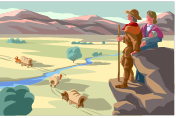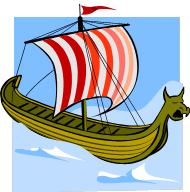Archive for the ‘Norway’ Category
Sharing Our Norwegian Research
 That time of year has rolled around again where I refocus my genealogical efforts from research to writing. Every November I choose an ancestor or ancestor couple as a writing subject. For Christmas, I distribute my finished product to my children and siblings and also to any interested cousins descended from that ancestor. I like this method of preserving and sharing my research.
That time of year has rolled around again where I refocus my genealogical efforts from research to writing. Every November I choose an ancestor or ancestor couple as a writing subject. For Christmas, I distribute my finished product to my children and siblings and also to any interested cousins descended from that ancestor. I like this method of preserving and sharing my research.
After my trip to Norway this summer, naturally I decided to write about Norwegian ancestors. My four Norwegian great-great-grandparents all lived in the same area of Nordland in the latter half of the 19th century, so I will prepare a compiled work on the four of them. I will include three items with the Christmas gift this year:
- Family group sheets for the Karen (1851-1916) and Nick (1854-1919) Bentsen family and for the Sivert Knudsen (1843-1907) and Martha Hansdatter (1841-1900) family,
- My only photograph of Karen and Nick Bentsen, and
- A character sketch I will write about the lives of these four people.
Amazingly, I have collected quite a bit of information on these ancestors, even though Sivert and Martha never left Norway. Much of that is due to the tireless efforts of my husband/tech advisor who has become quite an expert in navigating the online Norwegian archives.
He has a writing project of his own. He will share his expertise in Norwegian research in an upcoming guest blog post for Upfront with NGS, the National Genealogical Society blog. Stay tuned for the link when it appears.
Celebrating on October 31
 Today is All Hallows Eve, or Halloween, a secular name by which it is more commonly known. People will dress up in costumes and celebrate at parties complete with jack-o-lanterns, ghosts, spiders, witches, etc. My young grandchildren can hardly wait to rake in the candy when they go out trick-or-treating tonight.
Today is All Hallows Eve, or Halloween, a secular name by which it is more commonly known. People will dress up in costumes and celebrate at parties complete with jack-o-lanterns, ghosts, spiders, witches, etc. My young grandchildren can hardly wait to rake in the candy when they go out trick-or-treating tonight.
Yet October 31 historically has had a much more religious significance. Christians have long kept vigil this night for the observance of All Saints Day tomorrow.
Of even more significance to my family is that October 31 marks the beginning of the Protestant Reformation. On All Hallows Eve in 1517, Martin Luther nailed his 95 theses on the door of Wittenberg Church to protest the excesses of the Roman Catholic Church. This shocking act marked the beginning of the Reformation and the Lutheran faith.
Luther’s teaching spread far, and the Nordic countries quickly left the Roman church to embrace Lutheranism. My mother’s family in Norway and Finland followed the state-mandated Lutheran tradition for hundreds of years.
The Lutheran church records in these countries still exist. They provide valuable genealogical information to me in their lists of baptisms, confirmations, marriages, and burials. With these records, I can trace my family back many generations relatively easily.
So Halloween means more to me than just another secular party day. In addition to All Hallows Eve, it is the birthday of the Lutheran church. This year my Lutheran congregation celebrated, not with candy and costumes, but by performing Bach’s cantata #80 based on the great hymn of the Reformation, A Mighty Fortress Is Our God. I celebrate Reformation Day today, not just Halloween.
Searching for the Wrong Ancestors
 We all know that in genealogy we must carefully work backwards in time, verifying each fact for each ancestor. One mistake, and we run the risk of spending precious research time on the wrong people.
We all know that in genealogy we must carefully work backwards in time, verifying each fact for each ancestor. One mistake, and we run the risk of spending precious research time on the wrong people.
Earlier this year, we ignored this rule somewhat. We did some hasty research in an effort to glean as much information as we could before our trip to Norway. Did we spend time investigating the wrong ancestors? Yes and no.
In my husband/tech advisor’s line, we did take a wrong turn with the identity of one female ancestor. Luckily, the entire family comes from the same area in Norway. We visited the correct place despite the research error. We have since amended our family tree.
For my family line, we visited the island of Dønna in Helgeland, purported home of my great-great grandmother, Karen Marie Johansdatter Bentsen. We went to Titternes Farm, where she was born.
Imagine my surprise this week when I came across a family tree for her on Ancestry.com that is nothing like the tree I have built. It names different parents with origins in Denmark. Panic! How could I have made such a massive mistake?!
I pulled out everything I have collected for Karen Marie and reviewed all the evidence carefully. Everything points to the Helgeland origin. I do not think I have been researching the wrong ancestors; I think the person who contributed the tree to Ancestry made an error. Of course that tree lists no sources.
This happens when we take shortcuts. We need to do our research correctly so we do not waste our time and publish erroneous information.
I am glad to find that Karen Marie really seems to be from Dønna. It is a lovely place.
Prairie Housing Yesterday and Today
 Not much to report this week because we had new flooring installed on the main floor of our house. We spent a lot of time moving furniture around.
Not much to report this week because we had new flooring installed on the main floor of our house. We spent a lot of time moving furniture around.
My beautiful new floors got me to thinking about the housing my ancestors inhabited when they came to the western United States over 100 years ago. Certainly they did not start out with multi-level homes and lovely oak floors. They lived in sod houses, or soddies.
I wonder how they felt about that. My great-grandmothers Laura Riddle and Petronellia Reed had lived in nice homes in Michigan and Illinois. It must have been difficult for them to get used to living in a house made of dirt. Laura eventually worked her way up to a nicer frame house in Palisade, Nebraska. Petronellia hated her life on the Wyoming prairie, sold her homestead, and moved to Missouri. There she also lived in a frame house.
And what about my other homesteading family, my Norwegian ancestors, Ole and Sofie Bentsen? They had lived in fishing villages in Norway. Last summer I visited a fisherman’s cottage at the Helgeland Museum in Dønna, Norway. It would have been similar to the housing the Bentsens left behind when they immigrated. Similar in size to a soddy on the American plains, it even had a grass roof. Perhaps life in a soddy did not seem so strange to them.
Yet the Bentsens, too, eventually upgraded to a frame house on their farm near Redstone, Montana. Even if they did not mind the soddy as much as Laura and Petronellia did, they weren’t satisfied to stay in one forever. Like the rest of us, they continued to upgrade their housing.
Using Parish Records to Locate Previously-Unknown Children
 Genealogists get excited when they discover a previously-unknown child in a family tree. Often we do not know about those babies who were born and passed away between takings of the census. This week, I found two such unknown children.
Genealogists get excited when they discover a previously-unknown child in a family tree. Often we do not know about those babies who were born and passed away between takings of the census. This week, I found two such unknown children.
According to my Norwegian great-aunt Signe, my ancestors Sivert Knudsen and Martha Hansdatter of Nordland, Norway had twelve children of whom only four survived to adulthood. Signe had no information about the eight who had died, so I set out to find them. I knew that the online birth and death records of the Norwegian Lutheran Church http://arkivverket.no/eng/content/view/full/629 likely contained this information. But these records are not indexed, so I needed a research plan.
I took these steps:
- Time Line–I placed the birth dates of the known surviving children on a timeline to establish a range of dates to search. The mother was unwed and 20 years old when her first surviving child was born in 1861. She was 37 at the birth of the last in 1878. Large gaps existed between the births, so I found I needed to search all her theoretical child-bearing years, say, 1857 when Martha was 15 until 1891 when Martha would have been 50 years old.
- Location–I identified the likely parishes where the unknown children would have been recorded. Early in their marriage, Sivert and Martha lived in Øksnes parish, Nordland. By the time the third surviving child was born, they had moved to Hadsel parish. I needed to search the records of both parishes. I could begin in Øksnes and search from 1857 until 1870 when the third survivor was baptized in Hadsel. I would then search Hadsel records from 1870 to 1891.
- Search–I examined the birth and death records of these parishes year-by-year, looking for any previously-unknown children born to Sivert and Martha. On the first pass, I discovered three, born in 1868, 1872, and 1882.
- Search Again–This week I searched the Norwegian index that is coming online at Family Search for any records mentioning the parents Martha Hansdatter or Sivert Knudsen. There I found references to two stillborn children in Hadsel in 1874 and 1876. I had missed them earlier because I had not realized the parish death form used in those years listed stillbirths in a separate column from the other deaths. Lesson learned. Thanks, husband/tech advisor for pointing this out to me.
I still do not have the information on all twelve of the reported children in this family. But I have made progress by adding two more this week. So far, I know of nine of the Sivertsen children:
- 1861 Johan Andreas Martinsen
- 1866 Kaspara Helmine Sivertsdatter
- 1868 Anna Marie Birgitte Siversdatter ( died in 1869)
- 1870 Hans Edvard Sivertsen
- 1872 Karl Nordal Sivertsen (died in 1872)
- 1874 unnamed Sivertsdatter (stillborn)
- 1876 unnamed Sivertsen (stillborn)
- 1878 Sofie Marie Sivertsdatter—my great-grandmother who looks like a “miracle baby”
- 1882 unnamed Sivertsdatter (stillborn)
The Good, the Bad, and the Very Ugly Facts on Moving to the New Family Tree
Last week I wrote about my wish to enable a smooth transfer of data from the genealogical software I use, The Master Genealogist, to the cloud site offered by Family Search. Here is a guest post from someone who knows a whole lot more about this complex issue than I do, my husband/tech advisor:

Many of us are looking for a place to save our research in case none of our relatives wants it. Most of us use a Genealogy program of some sort but many have already “taken the plunge” and gone to online programs.
Those of us who haven’t gone to an online program, and even some of those that have, face the issue of what’s going to happen to our hard work when we can’t do it anymore. If we don’t migrate ourselves, our research is subject to the vagaries of a family member taking it over or performing the migration plan we might have left behind. Web sites we’ve built with our research will go away when the contract is up, causing the data to be lost.
The only solutions:
· to plan on a transfer to a repository and hope the heirs will do it and will be able to do it,
· to have a family member who will take it over,
· to identify a repository and synchronize to it,
· to identify a repository and switch to using their on-line software.
I can hope that a family member will continue the work – but unlikely at this point – or that enough peripheral people are working in my areas to take my work and run with it, but the reality is that it most likely will fade away as the paid web site expires or the software it’s based on becomes unusable unless I start ensuring continuity now.
Because I don’t like making other people pay someone else to see my hard-won research, I’ve chosen the LDS New Family Tree (NFT) as my repository and would like to synchronize to it. I currently use The Master Genealogist (TMG) version 8. Oops, based on both past experience and asking questions, I don’t think synchronization is coming soon.
Basically, I’d love to stay with TMG as I like the program and know how to use it. But if there aren’t plans to start doing what all the other major Genealogy programs are doing – synchronizing to NFT. Rather than enter more data into a dead end program, I’ll have to move to a program that is keeping up with the Joneses. And I have about 300 Norwegian and Danish relatives and over 500 sources to enter – a very productive summer.
Two programs are “certified” for synchronization with NFT – RootsMagic (RM) and Ancestral Quest (AQ). However, there are different levels of certification. You can also upload GEDCOMs to NFT regularly to synchronize – but I’m giving away the plot. I guess I’ll consider moving to RM or AQ.
There are several good web blogs about the pain and anguish and advantages of moving from TMG to each. The bottom line is that both do a decent job of importing from TMG via GEDCOM. But, from what the blogs say, RM, AQ, and – it turns out – NFT do not “nicely move sources from TMG. NFT requires sources and if no sources are attached to a person, that person is not considered to be a “good” record. When a GEDCOM from TMG is uploaded to NFT, the TMG sources are treated as notes rather than sources. When other major Genealogy programs use their “direct” link, sources remain attached – but according to bloggers, I can expect problems here.
I’ve done some investigation into what Synchronization really means. Say I have grandpa, and so does NFT. NFT doesn’t have grandma or grandpa’s parents. For grandpa, I have 4 sources and NFT has 2.
· If I use TMG and GEDCOM – each record is added to FamilySearch and none are put in my NFT Tree. When I add a person to my Tree, the sources come as details. The details can’t be converted to sources. No siblings, parents, spouses, or children come along – even if they are there in the Person Record – I have to manually find and attach each one – just because they are on the Person Record doesn’t mean I can attach them from there. Basically entirely manual after a painful process to upload the GEDCOM – requires matching checking and verification and adding the record to FamilySearch one by one.
· While on GEDCOM to NFT – most FAM tags seem to be ignored after the first generation.
· If I move from TMG to RM or AQ and do a Synchronize – the only difference is that once I have the person in my Tree, source and details placed in RM or AQ will then be placed into the Person Record which is available to NFT. New siblings, parents, spouses, or children are not attached – I must Find them and attach them.
Basically, to use NFT requires me to start over and completely re-enter my tree and all my sources.
Of course when asked about this, they tell me that should only take an hour or so. [Insert here Words that can’t be printed.] I’m looking at a minimum of ½ hour for every source. 95% of my sources are not in FamilySearch. My grandfather born in 1877 in Norway and who came to the US at 14 months has two census records that FamilySearch has. I have 26 sources, of which 6 are “governmental”. There’s 12 hours of data entry. An afternoon, my left foot.
One good reason not to use Family Tree directly is that they don’t really support PDFs, and they don’t like “active” PDFs. All of my Norwegian documents from Arkivverket are active PDFs – if you click anywhere on the PDF, it takes you to the real original image location. A nice touch and one that TMG handles very nicely. Too bad Arkivverket doesn’t advertise it so other archives will start doing this..
Basically, since I’ve spent the summer getting all these source documents, I have to make a choice – hope that there will be a way to get them in Family Tree, give up on TMG and use a program that will put them in Family Tree, or just use Family Tree directly.
But I’d rather stay on TMG.
TONY HJELMSTAD
Norwegian Property Marks Identified
 Earlier this week, I wrote of mysterious symbols we found in a 1771 Norwegian marriage record from Hordaland. I vowed to find out more about them. I soon learned that they are known as Bumerker.
Earlier this week, I wrote of mysterious symbols we found in a 1771 Norwegian marriage record from Hordaland. I vowed to find out more about them. I soon learned that they are known as Bumerker.
Norwegians used these family symbols to identify and mark their property. Those who could not read and write also used them to sign documents. The markings may have been derived from runic alphabets or pagan symbols, but by 1771 they had no such meaning. Instead, they were more like the cattle brands used in the American West.
How did I get my answer so quickly? I felt that someone in the genealogical community must know about these symbols, so I just put my question “out there” via my blog, Twitter, and the Hordaland message board on Ancestry. By the next morning, I received responses to my question. One pointed me to a good article about Bumerker on the Norway Heritage website (http://www.norwayheritage.com/Property-Marks-in-Rural-Norway.htm).
In the end, nothing mysterious was going on here. Instead, I learned something new and took another step in my ongoing genealogical education. Thanks to everyone who helped me along.
Pagan-like Symbols on a Norwegian Marriage Record
 Imagine our surprise when we unearthed a Church of Norway (Lutheran) marriage record decorated with pagan-like symbols. The record comes from the Voss, Hordaland Ministerialbok, 1731-1773. On page 148 we found my ancestors, Mons Eriksen and Brita Christoffersdatter, wed in 1771. Every entry on the page includes a couple of tiny, mysterious drawings.
Imagine our surprise when we unearthed a Church of Norway (Lutheran) marriage record decorated with pagan-like symbols. The record comes from the Voss, Hordaland Ministerialbok, 1731-1773. On page 148 we found my ancestors, Mons Eriksen and Brita Christoffersdatter, wed in 1771. Every entry on the page includes a couple of tiny, mysterious drawings.
In the words of Martin Luther, “What Does This Mean?” We do not really know, but we would love to find out. Do the symbols apply to the bride and groom? Their families or best men? The farms where they lived?
I have learned that the Voss area was Christianized late and forcibly so by St. Olaf. Perhaps these symbols date from Norway’s pagan era. But why add them to a Christian marriage record? Someone must have an answer, and I need to begin searching for the person who can explain.
Calling All Relatives in Norway
 Since our return from our trip to Norway we have heard the same question asked: Did you look up your relatives? The short answer is “No”. Even though we might have been interested in doing so, we did not even try.
Since our return from our trip to Norway we have heard the same question asked: Did you look up your relatives? The short answer is “No”. Even though we might have been interested in doing so, we did not even try.
For many reasons, we do not know the names of any of our Norwegian cousins or where they might live:
- Our great-grandparents emigrated with their extended families. Any people who remained behind were their cousins, meaning that relatives alive today are quite remote to us, fourth cousins or so. The American and Norwegian families have not been in touch since our great-grandparents died in the early-to-mid twentieth century. We have no contact information for any relatives residing in Norway today.
- Our families left when Norway still used the patronymic system based on the given name of one’s father. No one had a surname that we can trace. That changed in Norway only about 1920, long after our families had left. We do not know what names the Norway families chose as surnames. They may not call themselves the same names chosen by those who emigrated—Hjelmstad and Walstad (chosen from farm names in Norway) or Bentsen (chosen from the patronymic of one immigrant’s grandfather).
- Although my husband/tech advisor could have distant relatives remaining in the same Ringsaker region where his family always lived, I do not know where to begin looking for mine. They lived in fishing villages on the numerous islands of Lofoten and Vesterålen. Today, the Norwegian government pays residents to leave these small, remote islands. Where would I look now for relatives?
- Our website displays our family tree back to the 1600’s on many Norwegian lines. No descendants living in Norway have ever contacted us.
That said, I must confess that several Norwegians we encountered on our trip asked us whether we planned to visit relatives. “They would want to meet you!” they said. When we explained we did not know of any relatives, they said that is no excuse.
One shopkeeper strongly advised us to visit the local record repository. He claimed they would identify and locate all our relatives for us within the hour. Really?
We did not try it because we had a tight schedule. Not wanting to miss out on seeing some of the sites on our itinerary, we opted to continue with our trip as planned. But if anyone else in the family visits Norway, it might be fun to try looking up the relatives. They would want to meet you!
Ancestors and Church Life
 I think I knew that church membership played an important role in the lives of our ancestors. As a product of the American system of a separated church and state, I just did not appreciate how extensive a role it played for these people. Recently, as I entered a lot of data derived from Church of Norway documents into my computer program, I came to realize how fully the Scandinavians in the 18th and 19th centuries entwined church life and everyday life.
I think I knew that church membership played an important role in the lives of our ancestors. As a product of the American system of a separated church and state, I just did not appreciate how extensive a role it played for these people. Recently, as I entered a lot of data derived from Church of Norway documents into my computer program, I came to realize how fully the Scandinavians in the 18th and 19th centuries entwined church life and everyday life.
They marked their rites of passage in Lutheran religious ceremonies—baptism, confirmation, marriage, and burial. The church carefully recorded these important occasions, and we can view the records today, hundreds of years later. In addition to facts about the event, the records also provide information on names of an ancestor’s parents and the places they lived. They even reveal the name of the father if a child was illegitimate.
Yet the church affected more than just the individual behavior reflected in the records. It was the reason for some modern reforms in Scandinavian society. For example, Norway in the 1700’s instituted a nationwide push for literacy. Why? So the people could pass the 700-question confirmation test. The pastor recorded their scores for posterity—not so good, good, or very good.
Why would a young Norwegian, or anyone, want to take and pass this difficult confirmation test? Because you could not get married in Norway unless you did. Every parish pastor asked for confirmation date and place before performing a marriage ceremony. That information, along with information pertinent to the marriage, is recorded on the nuptial record.
Even today, although most Norwegians claim they are not religious, the Church of Norway retains its official state status. It receives its financial support from the state. All clergy are state employees. The King of Norway is required to be Lutheran. The Church still has its role there, affecting the everyday lives of most Norwegians.